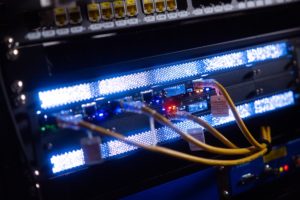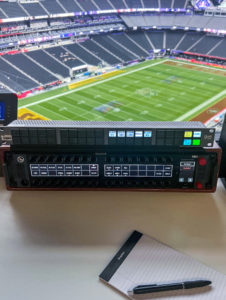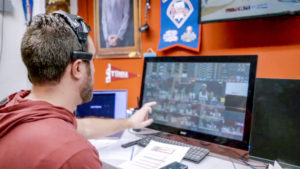
Bevan Gibson
CTO, EMG
When we talk about location production, our thoughts and processes are primarily driven by sport. This has always been the genre which has seen the most innovation: more cameras delivering more angles; more replays; more graphics; new formats like 4K and HDR UHD. Sports fans want to be continually engaged and informed: they want to understand the plays as well as appreciate them.
This inevitably makes it a technology-intensive operation. A big football game might have more than 30 cameras, each one with a slo-mo replay channel attached, plus motion graphics, statistical overlays and more. Controlling all those inputs means a big production switcher, and sometimes a second truck for replays.
So we have reached the stage where outside broadcast trucks are at the very limit of size and weight to make it onto public roads, yet still present a cramped operating environment in which the production team must work under great pressure. At EMG, with sustainability in mind, we have long been looking at how we can take a completely fresh approach.

The result is our IP fly-pack system we call diPloy. This modular production system is designed to cope with the largest sports events and our original goal was the multi-sport event planned for Tokyo in 2020, now likely to take place in 2021. Built into modular racks of varying sizes in dedicated 40-foot containers, diPloy allows us to plug together the functionality we want for each particular job. Even more important, it allows us to physically place modules where they are most appropriate – which could mean some at the location, others at any distance.
There is a huge advantage in complete remote production: putting the cameras and microphones at the event, but bringing all the signals back to a central production area at your headquarters, or even to explore distributed production facilities. Most obviously, this allows you to build the control rooms for comfortable and efficient operation, not to fit inside the physical dimensions of a truck.
The central control suite can then be used intensively. A more traditional truck might cover one football game in three days: with remote production, the control room could output three games in one day. That level of productivity allows the service provider, like EMG, to invest in the latest technology to engage audiences.
How does diPloy fit into this? The endgame is that you simply shift the endpoint modules to the location and use them to transport all the signals back to base. That way, you only transport the hardware you really need – unlike today when a 30-camera truck might be used for a six-camera opera or snooker shoot.
EMG already has a diPloy central production suite operational in the Netherlands, and we will shortly enhance our remote operations centres in UK and further across the Group with the same technology.
In the near term, we can build flexible outside broadcast units which use remote technology while still using a suitably-equipped truck. A great example was the 2021 FIS Nordic World Championships in Oberstdorf, where we provided host broadcast facilities for the cross-country skiing and ski jump competitions.
We produced from a centralised IP fly-pack based near the cross-country finish area. diPloy modules were placed around the cross-country ski course to bring cameras and microphones back to the truck. The ski jump hill was some five kilometres away, and again all the sources were brought back to the core system in the cross-country stadium.
Obviously diPloy depends upon IP connectivity and the SMPTE ST 2110 family of standards. This allows us to treat every source as an individual camera or microphone, exactly as we would have done in a traditional outside broadcast, but route them in multiplexes over dark fibre.

Critical to the diPloy architecture is the Selenio Network Processor (SNP) from Imagine Communications. This does two things for us.
First, it provides an interface to high-speed IP connectivity – up to 400 gigabit ethernet in the latest version. It also provides a time reference point in a PTP network, which makes system timing across a diverse network practical.
Second, the SNP is a powerful processor. To be precise, each 1RU device has four separate processor chains, running on FPGAs which are software defined. These software personalities allow us to build precisely the functionality we need.
One of the main tasks is format conversion: between 4K and HD, and between standard dynamic range and the various flavours of high dynamic range. Add in the multiviewer capability, and the SNP is vital just for managing and monitoring signals.
SNP also has the ability to bridge between IP and SDI, so legacy equipment can be easily connected into the network without latency or timing errors. We have huge numbers of EVS HD replay servers, for example, and SNPs can provide the SDI I/O in an IP production – 32 channels in a single SNP.
Many more software personalities are available for SNP: it can be used as a video proc amp, for example. It can also be used as a stage box, concentrating multiple camera and audio feeds onto a single fiber for the run back to the truck or central processing area.
We are aware that recent SNP updates also activate the feature licensing system, which will enable companies like us to realize one of the key benefits of virtualised software: the ability to pay for only the functionality required for specific workflows. This means that the hardware can be installed once enabling us to only buy the features we need to do the job at hand, and add functionality later as needs evolve.

We have an excellent relationship with Imagine, which allows us to see what is coming up for SNP. In particular, we are excited by the prospect of JPEG XS compression in SNP, which will help us to get even more circuits from a remote location over constrained bandwidth.
Our use of the SNP reflects our ambition for diPloy. We are service providers, so we have developed a production architecture which our clients can use in precisely the way they want. Whatever facilities they need, and wherever they need to operate them, we can software configure diPloy to do it.
Within diPloy, we software configure our SNPs to provide the workflow, the signals and the access that our clients need. On both levels, it is a common architecture made infinitely flexible through the software.









